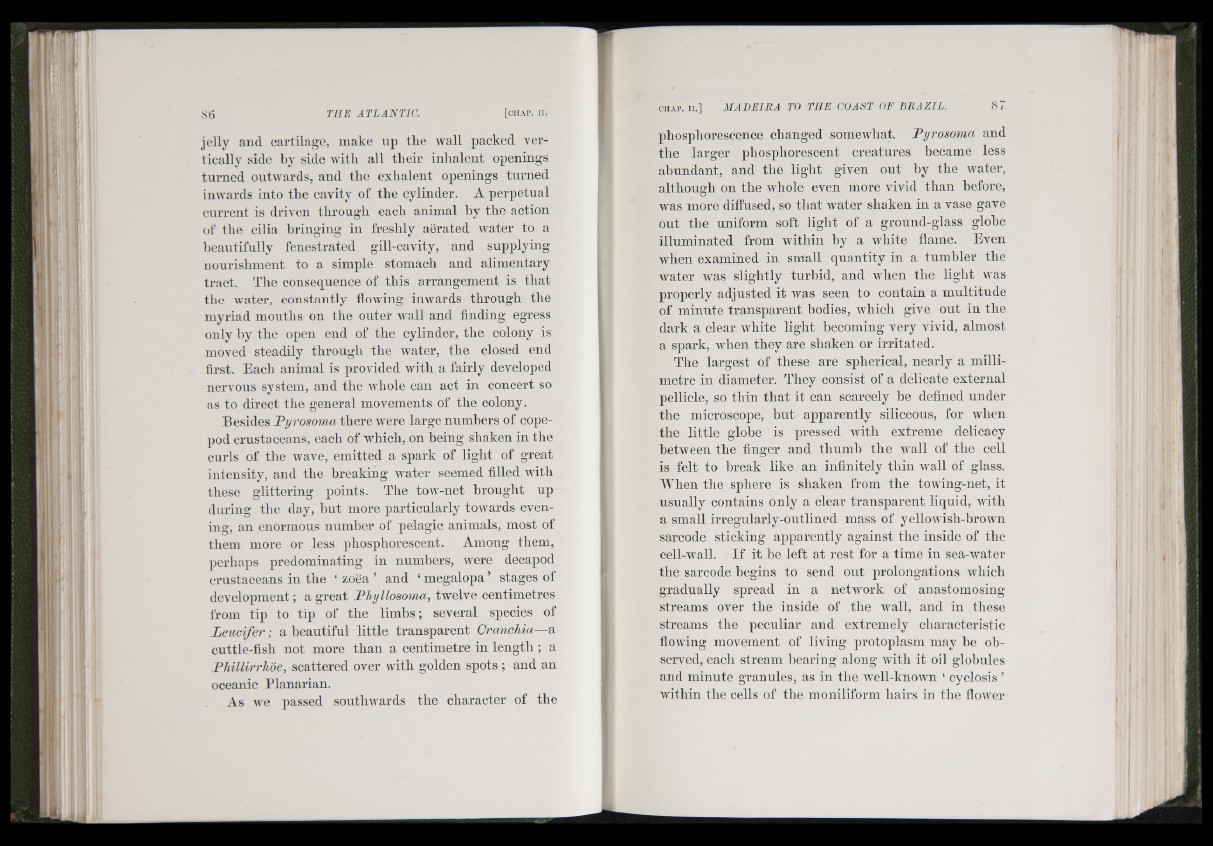
jelly and cartilage, make up the wall packed vertically
side by side with all their inhalent openings
turned outwards, and the exhalent openings turned
iiiAvards into the cavity of the cylinder. A perpetual
current is driven through each animal by the action
of the cilia bringing in freshly aerated water to a
beautifully fenestrated gill-cavity, and supplying
nourishment to a simple stomach and alimentary
tract. The consequence of this arrangement is that
the water, constantly flowing inwards through the
myriad mouths on the outer wall and finding egress
only by the open end of the cylinder, the colony is
moved steadily through the water, the closed end
first. Each animal is provided with a fairly developed
nervous system, and the whole can act in concert so
as to direct the general movements of the colony.
Besides Byrosoma there were large numbers of cope-
pod crustaceans, each of which, on heing shaken in the
curls of the wave, emitted a spark of light of great
intensity, and the breaking water seemed filled with
these glittering points. The tow-net brought up
during the day, but more particularly towards evening,
an enormous number of pelagic animals, most of
them more or less phosphorescent. Among them,
perhaps predominating in numbers, were decapod
crustaceans in the ‘ zoëa ’ and ‘ megalopa ’ stages of
development ; a great Bliyllosoma, twelve centimetres
from tip to tip of the limbs; several species of
Leucifer ; a beautiful little transparent Crancliia—a
cuttle-fish not more than a centimetre in length ; a
Fhillirrhoe, scattered over with golden spots ; and an
oceanic Planarian.
As we passed soutliAvards the character of the
■Bll
phosphorescence changed somewhat. Byrosoma and
the larger phosphorescent creatures became less
abundant, and the light given out by the water,
although on the whole even more vivid th an hefore,
Avas more difihsed, so th a t water shaken in a vase gave
out the uniform soft light of a ground-glass globe
illuminated from within hy a Avliite flame. Even
when examined in small quantity in a tumbler the
Avater was slightly turbid, and when the light was
properly adjusted it was seen to contain a multitude
of minute transparent bodies, Avhich give out in the
dark a clear white light becoming very vivid, almost
a spark, Avhen they are shaken or irritated.
The largest of these are spherical, nearly a millimetre
in diameter. They consist of a delicate external
pellicle, so th in th a t it can scarcely he defined under
the microscope, h u t apparently siliceous, for when
the little globe is pressed Avith extreme delicacy
between the finger and thumh th e Avail of the cell
is felt to break like an infinitely th in Avail of glass.
When the sphere is shaken from the towing-net, it
usually contains only a clear transparent liquid, Avith
a small irregularly-outlined mass of yelloAvish-brown
sarcode sticking apparently against the inside of the
cell-wall. I f it be left at rest for a time in sea-Avater
the sarcode begins to send ont prolongations which
gradually spread in a netAvork of anastomosing
streams over the inside of the Avail, and in these
streams the peculiar and extremely characteristic
flowing movement of living protoplasm may he observed,
each stream hearing along with it oil globules
and minute granules, as in the AA'ell-knoAvn ‘ cyclosis ’
within the cells of the mouiliform hairs in the floAAYu*